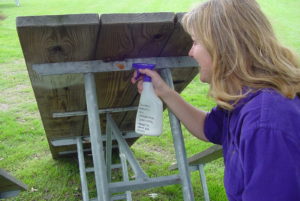By Bill McNee, DNR forest health specialist, Oshkosh, Bill.McNee@wisconsin.gov, 920-360-0942
Fall is an excellent time to look for and dispose of gypsy moth egg masses that were laid in the summer. Since egg masses usually don’t hatch until April, information gained from fall/winter surveys can be used to avoid gypsy moth damage before the following spring and summer.

Spraying egg masses with oil kills the eggs inside, preventing hundreds of caterpillars from hatching next spring.
Gypsy moth egg masses are felt-like, tan-colored patches about the size of a nickel or quarter. Female adult moths often lay these masses on tree trunks, the undersides of branches, buildings, firewood or wood piles and on vehicles and other outdoor objects. To learn how to survey for egg masses on your property, check out this webpage from UW-Extension.
The best time to remove egg masses is after tree leaves drop in the fall. If found, remove or spray those that are safely within reach. If only a few are found, accessible ones can be sprayed with horticultural oil, which is available online or at many home and garden centers. Egg masses can also be gently scraped into a container of soapy water to soak for a few days before being discarded in the trash. Do not use motor oil or mineral oil that can cause unnecessary damage to trees.
Target “fresh” egg masses that were produced during the summer. These will be firm and darker tan than older egg masses which appear faded and have a spongy texture.
This resource from UW-Extension and Wisconsin DNR provides more information on identifying and managing gypsy moth in the egg mass stage. For more about gypsy moth and other control methods, visit the Wisconsin gypsy moth portal.
